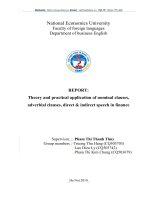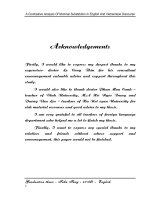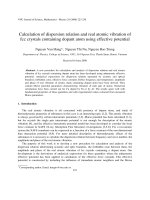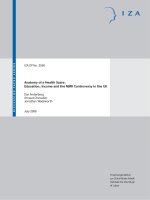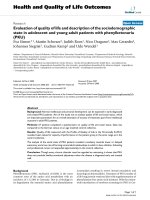Revision of Nominal Effective Exchange Rate (NEER) and Real Effective Exchange Rate (REER) Indices.doc
Bạn đang xem bản rút gọn của tài liệu. Xem và tải ngay bản đầy đủ của tài liệu tại đây (155.65 KB, 8 trang )
Revision of Nominal Effective Exchange Rate (NEER) and Real Effective Exchange Rate (REER) Indices
*
The indices of Nominal Effective Exchange Rate (NEER) and Real Effective Exchange Rate (REER) are used as indicators of
external competitiveness. NEER is the weighted average of bilateral nominal exchange rates of the home currency in terms of
foreign currencies. Conceptually, the REER, defined as a weighted average of nominal exchange rates adjusted for relative price
differential between the domestic and foreign countries, relates to the purchasing power parity (PPP) hypothesis.
The Reserve Bank of India (RBI) has been constructing five-country and thirty six-country indices of NEER and REER as part of
its communication policy and to aid researchers and analysts. Theses indices are published in the Bank’s monthly Bulletin. Three
major developments as set out in the following paragraphs have necessitated a review of the existing indices.
First, introduction of the Euro (notes and coins) with effect from January 1, 2002 necessitated the need to replace the existing
national currencies of the Euro zone by the common currency for the members, which formed part of RBI’s 5-country and 36-
country REER/NEER indices. The European Commission (Eurostat) introduced a harmonised index of consumer prices (HICP)
for the member countries, which entailed individual consumer price indices to be replaced by HICP in the construction of the
REER. Second, there has been a significant shift in India’s trade relations across countries/regions, mainly towards developing
and emerging economies during the last decade, requiring a change in the currency basket and the weights assigned to India’s
trading partners included in the REER. Third, the base year of the Wholesale Price Index of India (WPI), was changed to 1993-
94, necessitating a change in the base year for 36-country REER and NEER indices.
Against the above backdrop, the Reserve Bank has now decided to replace its existing 5-country indices with new six-currency
indices of NEER/REER. The thirty six-country indices have also been revised and replaced with new 36-currency indices of
NEER/REER. In this regard, the RBI Press Release dated November 4, 2005 had set out the broad outline of the revision of the
REER/NEER indices. As indicated in the Press Release, this is a detailed article elaborating upon the methodology adopted in
the construction of the new series and the conceptual issues involved such as the coverage, the base year, prices and weights
that are chosen and the rationale there-in. The time series data on the new 6-currency and 36-currency indices along with their
broad trends have also been examined.
I. THE METHODOLOGY
The NEER is the weighted geometric average of the bilateral nominal exchange rates of the home currency in terms of foreign
currencies. Specifically,
The REER is the weighted average of NEER adjusted by the ratio of domestic price to foreign prices. Specifically,
Where e : Exchange rate of Indian rupee against a numeraire, i.e., the IMF’s Special Drawing Rights (SDRs) in indexed form,
* Prepared jointly in the Division of International Finance, Department of Economic Analysis and Policy and the Department of
External Investments and Operations, Reserve Bank of India.
As set out in the methodology, the REER has four parameters/variables pertaining to country/currency coverage (n), relative
prices (P/Pi), weights (wi) and exchange rates (e/ei). The revision of REER relating to
the above parameters/variables is as follows.
II. COVERAGE
The new six-currency indices represent the US, the Eurozone (comprising of 12 countries), UK, Japan, China and Hong Kong
SAR. Two currencies in the existing five-country series, viz., French franc and Deutsche mark have been replaced by the Euro in
the new indices. Two new currencies have been included in the new indices, both being Asian - the Chinese yuan and the Hong
Kong Dollar.
The rapid growth in India’s foreign trade with China and Hong Kong in the recent years has been the underlying factor for
including these two countries in the new six-currency REER. China and Hong Kong SAR together accounted for around 9 per
cent of India’s foreign trade in 2004-05. China’s share in India’s foreign trade has surged from 0.2 per cent in 1991-92 to 6.1 per
cent in 2004-05. The increase in India’s trade with China has been more pronounced in the last four years. The inclusion of
China and Hong Kong SAR reflects an increasing recognition of the Indian economy’s rapidly growing integration with the
developing and emerging Asian economies. The six countries/regions, represented by the six currencies, together accounted for
around 40 per cent of India’s total foreign trade in 2004-05 as compared with a lower coverage of around 22 per cent of India’s
total foreign trade in the case of the existing five-country index.
The coverage has also been revised for the 36-country REER/NEER indices. The old indices comprised 36 countries including
five members of the Euro Area
1
. With an objective to broad base the REER/NEER and also to highlight India’s changing trade
pattern, countries have been chosen in the new series based on three broad criteria: (i) the share in India’s exports and trade, (ii)
regional representation and (iii) the regular availability of data on exchange rates and prices on a monthly basis. The new
countries included in the revised series are Hong Kong SAR, Denmark, Iran, Kuwait, Qatar, Russia, South Africa, Sweden and
United Arab Emirates (Annex). Besides, with the inclusion of the Euro zone, the new 36-currency indices include all the twelve
countries that have Euro as common currency. Thus, the revised 36-currency REER indices effectively represent 47 countries.
The revised thirty-six countries/regions, represented by the thirty-six currencies, together accounted for, on an average, 77 per
cent and 89 per cent of India’s total foreign trade and exports respectively during 2002-03 to 2004-05 as against a lower
coverage of around 61 per cent and 66 per cent of India’s total foreign trade and exports, respectively in the existing indices.
III. PRICES
In line with the existing practice, the revised indices (both 6-currency and 36-currency) use the wholesale price index (WPI) as a
proxy for Indian prices and the consumer price index (CPI) as a proxy for foreign partner countries. While CPI is more
representative of the cost/ inflationary conditions in the markets to which most of India’s exports are directed, WPI reflects the
producer costs. The weekly wholesale price index (WPI) for all commodities is used as an index of inflation for India in
calculating six-currency REER/NEER indices. While the 6-currency index updates the WPI data every week, it is updated
monthly for the 36-currency index. China provides year-on-year monthly CPI growth rates, which have been converted into
indices by taking 1993-94 as the base year.
Unlike in the case of the 6-currency index, the CPI data are not readily available for few of our trading partners, which form part
of the 36-currency index. Hence,
1 The Euro area was representative of five countries namely Belgium, France, Germany, Italy and Netherlands.
suitable alternatives have been used. WPI is used as a proxy for prices for Australia since the CPI data are available on a
quarterly basis. CPI data are not readily available for United Arab Emirates (UAE), which remains an important trading partner
for India and for Quatar. Hence, CPI for the Middle East region as given in the International Financial Statistics (IFS) of IMF is
used as a proxy for prices for these countries.
IV. EXCHANGE RATE
The Special Drawing Right (SDR) has been chosen as the numeraire currency in the construction of REER/ NEER indices since
the exchange value of the SDR is determined by a weighted average of a basket of currencies, which would offset fluctuations in
individual currencies. Moreover, from a statistical perspective, the choice of SDR as numeraire facilitates inclusion of the US,
which is a major trading partner of India. The exchange rate of a currency is expressed as the number of units of numaraire
(SDRs) per ith currency. A rise in ‘e’ or ‘e/ei,’ thus represents an appreciation of rupee relative to the currency i and vice versa,
where e represents exchange rate of Indian rupee against the numeraire, SDR in indexed form and ei represents exchange rate
of foreign currency ‘i’ against the numeraire (SDRs) in indexed form.
V. BASE YEAR
The monthly average of the REER and NEER for the base year is benchmarked to the level of 100. As against the practice of
having three base years in the case of existing five-country indices, viz., 1991-92, 1993-94 and 2003-04, the last being a moving
base updated every year to facilitate comparison with a more recent period, the new six-currency indices will have two base
years, 1993-94 as fixed base and 2003-04 as a moving base, which would change every year as at present. As regards, the
broad-based indices, the old 36-country indices were constructed with 1985 as the base period. The year 1993-94 is chosen as
the base year for the revised 36-currency REER/NEER series in line with the WPI base year. In this connection, it may be
mentioned that though the choice of the base year affects the level of REER/NEER for rest of the time period, the indices being
geometric series, the percentage difference between any two periods remains same, whatever be the base year.
The choice of the base year 1993-94 is attributable to the significant changes in the macroeconomic environment due to
structural reforms introduced in the wake of balance of payments crisis in 1990-91. India adopted a market determined exchange
rate regime since April 1993. This is also supported by generally stable macroeconomic and external sector performance during
that year.
VI. WEIGHTS
The existing five-country indices use fixed trade weights, which are based on the average of India’s bilateral trade (exports plus
imports) with the countries in the index during the five-year period from 1992-93 to 1996-97. The new six-currency indices use a
3-year moving average trade weights in place of the present fixed trade weights with a view to suitably reflect the dynamically
changing pattern of India’s foreign trade with its major trading partners. In order to calculate the weights, the geometric average
of India’s bilateral trade (exports plus imports) with countries/regions represented by the six-currencies during the preceding
three years has been taken. This has then been normalised to arrive at the requisite weights (wi), which are provided in Table 1.
As in case of the revised indices of the six-currency REER/NEER, the thirty six-currency indices also use 3-year moving average
normalized weights (both exports and trade weights) in the construction of the new series, keeping in view the rapid change in
the destinations of India’s foreign trade in contrast to the fixed weights used hitherto for constructing REER/NEER series. Table
2 gives the normalized weights for the 36-currencies for the year 2005-06, which is based on trade shares of previous three
years.
Table 1: Normalised weights for 6-currency REER/NEER Indices
(In per cent)
Year Euro Japan UK USAHongkon
g
China
1993-94 42.06 14.01 12.04 26.33 4.55 1.01
1994-95 40.25 13.50 11.73 26.95 5.40 2.17
1995-96 39.22 13.44 11.33 26.95 6.07 2.98
1996-97 38.95 12.87 11.25 27.29 6.15 3.49
1997-98 39.28 11.76 11.55 27.46 6.03 4.20
1998-99 38.71 11.03 11.82 28.21 6.03 4.20
1999-00 37.79 10.64 11.86 28.59 6.68 4.44
2000-01 36.67 9.92 12.15 29.12 7.48 4.65
2001-02 35.88 9.30 12.06 29.08 8.02 5.67
2002-03 35.55 8.31 11.67 29.51 7.67 7.29
2003-04 35.52 7.85 10.84 28.90 7.55 9.34
2004-05 35.12 7.15 10.13 28.19 7.45 11.96
Table 2: 36-currency Normalised Weights for 2005-06
(in per cent)
Country Trade Weight Export Weight
Argentina 0.53 0.17
Australia 2.66 1.03
Bangladesh 1.40 2.61
Brazil 0.79 0.78
Canada 1.30 1.33
China 6.69 5.52
Hong Kong 4.08 5.52
Denmark 0.40 0.41
Egypt 0.47 0.63
Euro 19.37 18.38
Indonesia 2.73 1.87
Iran 1.09 1.58
Israel 1.36 1.35
Japan 3.95 3.26
Kenya 0.28 0.47
Korea 2.94 1.38
Kuwait 0.47 0.56
Malaysia 2.51 1.56
Mexico 0.33 0.51
Myanmar 0.43 0.16
Nigeria 0.55 0.95
Pakistan 0.34 0.55
Philippines 0.48 0.69
Qatar 0.35 0.24
Russia 1.45 1.18
Saudi Arabia 1.74 1.99
Singapore 3.85 3.97
South Africa 2.44 1.11
Sri Lanka 1.25 2.07
Sweden 0.81 0.36
Switzerland 3.63 0.79
Thailand 1.26 1.41
Turkey 0.55 0.92

